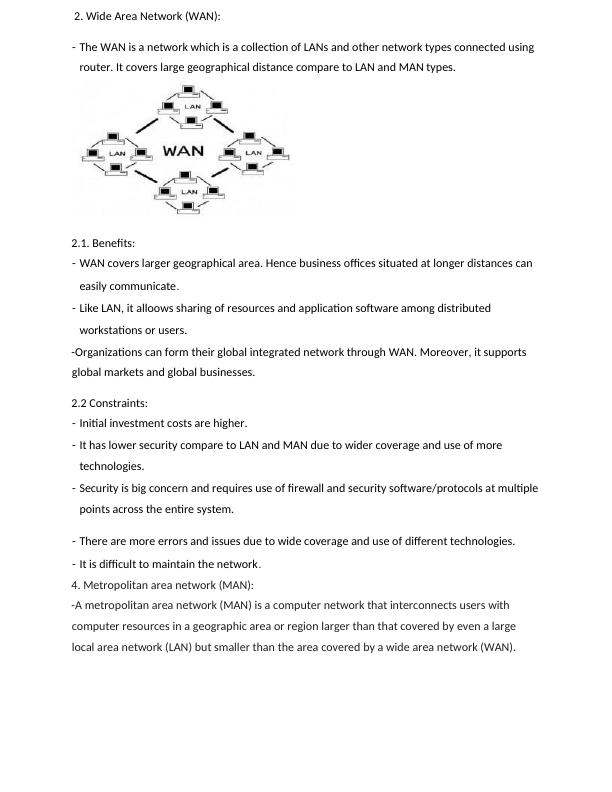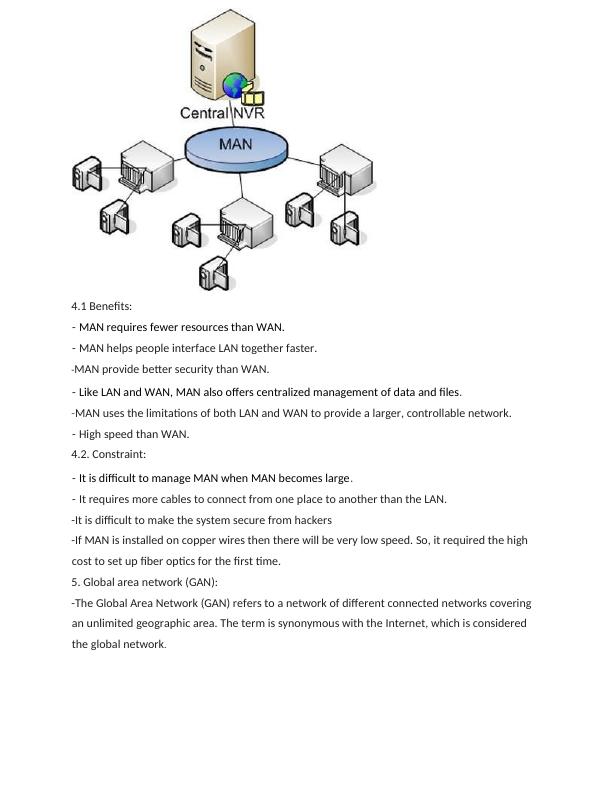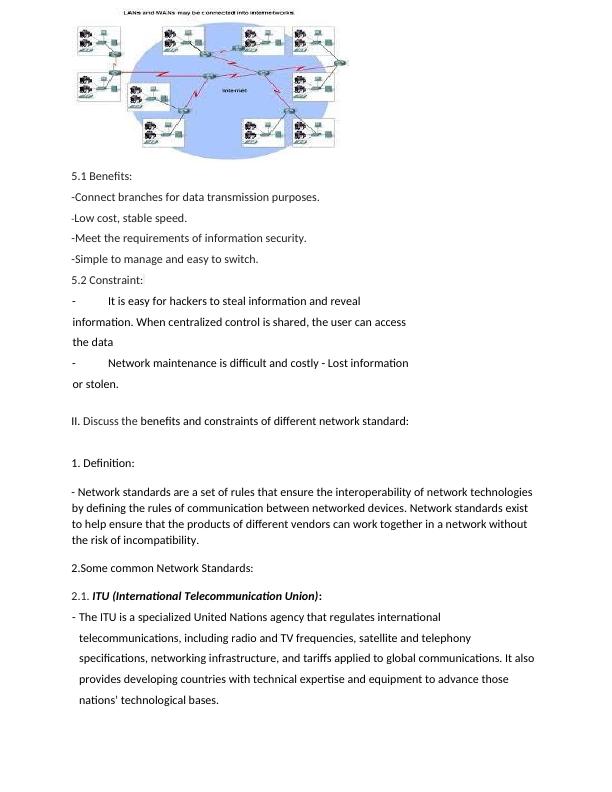Ask a question from expert
Benefits and Constraints of Different Network Types
22 Pages5141 Words7484 Views
Added on 2021-08-16
About This Document
This assignment is on the benefits and constraints of different network types. -A metropolitan area network is a computer network that interconnects users.
Benefits and Constraints of Different Network Types
Added on 2021-08-16
BookmarkShareRelated Documents
Benefits and constraints of different network types and standards.
I. Discuss the benefits and constraints of different network types:
1. Local Area Networks (LAN):
- Local Area Network (LAN) is a high-speed communications system designed to connect
computers and other data processing devices working together in a small geographical
area such as a floor of the building, or in a building....
1.1 Benefits:
- Initial investment costs are lower.
- Devices that are connected to the LAN can easily share or transfer data to each other.
- Can connect to other peripherals such as printers, photocopiers ....
- Computers can use the same an application.
- Easily install security protocols to protect LAN users from intruders or hackers.
1.2 . Constraints:
- LAN covers small geographical area.
- In the server based on LAN architecture, if server develops some fault, all the users are
affected.
- Appearance of virus in one system can spread very fast to all the LAN users very easily.

2. Wide Area Network (WAN):
- The WAN is a network which is a collection of LANs and other network types connected using
router. It covers large geographical distance compare to LAN and MAN types.
2.1. Benefits:
- WAN covers larger geographical area. Hence business offices situated at longer distances can
easily communicate.
- Like LAN, it alloows sharing of resources and application software among distributed
workstations or users.
-Organizations can form their global integrated network through WAN. Moreover, it supports
global markets and global businesses.
2.2 Constraints:
- Initial investment costs are higher.
- It has lower security compare to LAN and MAN due to wider coverage and use of more
technologies.
- Security is big concern and requires use of firewall and security software/protocols at multiple
points across the entire system.
- There are more errors and issues due to wide coverage and use of different technologies.
- It is difficult to maintain the network.
4. Metropolitan area network (MAN):
-A metropolitan area network (MAN) is a computer network that interconnects users with
computer resources in a geographic area or region larger than that covered by even a large
local area network (LAN) but smaller than the area covered by a wide area network (WAN).
- The WAN is a network which is a collection of LANs and other network types connected using
router. It covers large geographical distance compare to LAN and MAN types.
2.1. Benefits:
- WAN covers larger geographical area. Hence business offices situated at longer distances can
easily communicate.
- Like LAN, it alloows sharing of resources and application software among distributed
workstations or users.
-Organizations can form their global integrated network through WAN. Moreover, it supports
global markets and global businesses.
2.2 Constraints:
- Initial investment costs are higher.
- It has lower security compare to LAN and MAN due to wider coverage and use of more
technologies.
- Security is big concern and requires use of firewall and security software/protocols at multiple
points across the entire system.
- There are more errors and issues due to wide coverage and use of different technologies.
- It is difficult to maintain the network.
4. Metropolitan area network (MAN):
-A metropolitan area network (MAN) is a computer network that interconnects users with
computer resources in a geographic area or region larger than that covered by even a large
local area network (LAN) but smaller than the area covered by a wide area network (WAN).

4.1 Benefits:
- MAN requires fewer resources than WAN.
- MAN helps people interface LAN together faster.
-MAN provide better security than WAN.
- Like LAN and WAN, MAN also offers centralized management of data and files.
-MAN uses the limitations of both LAN and WAN to provide a larger, controllable network.
- High speed than WAN.
4.2. Constraint:
- It is difficult to manage MAN when MAN becomes large.
- It requires more cables to connect from one place to another than the LAN.
-It is difficult to make the system secure from hackers
-If MAN is installed on copper wires then there will be very low speed. So, it required the high
cost to set up fiber optics for the first time.
5. Global area network (GAN):
-The Global Area Network (GAN) refers to a network of different connected networks covering
an unlimited geographic area. The term is synonymous with the Internet, which is considered
the global network.

5.1 Benefits:
-Connect branches for data transmission purposes.
-Low cost, stable speed.
-Meet the requirements of information security.
-Simple to manage and easy to switch.
5.2 Constraint:
- It is easy for hackers to steal information and reveal
information. When centralized control is shared, the user can access
the data
- Network maintenance is difficult and costly - Lost information
or stolen.
II. Discuss the benefits and constraints of different network standard:
1. Definition:
- Network standards are a set of rules that ensure the interoperability of network technologies
by defining the rules of communication between networked devices. Network standards exist
to help ensure that the products of different vendors can work together in a network without
the risk of incompatibility.
2.Some common Network Standards:
2.1. ITU (International Telecommunication Union):
- The ITU is a specialized United Nations agency that regulates international
telecommunications, including radio and TV frequencies, satellite and telephony
specifications, networking infrastructure, and tariffs applied to global communications. It also
provides developing countries with technical expertise and equipment to advance those
nations’ technological bases.

- The main activities of the ITU cover all aspects of the field telecommunications sector. ITU
hasthree main areas of activity:
+ITU-R (Radiocommunication Sector): play an important role in the global management of
radio frequency resources and satellite orbits, construction Establish international standards for
radio communication systems.
+ ITU-T (Telecommunication Standardization Sector): a collection of experts from all over the
world to build international standards known by name. The ITU-T Recommendation, which
determines the global infrastructure of the public information and communication technology.
+ ITU-D (Development Sector): efforts to replicate telecom access Fair and reasonable as a way
to stimulate socio-economic development Wider.
- The purpose of ITU-T is to build, publish, disseminate and monitor the application.
Recommendation for standardization of telecommunications activities on a global level,
through research technical issues, manipulation and tariffs on international media. Currently
active ITU-T standardization is conducted by:
- Media Advisory Group (TSAG);
- Research Groups (SG);
- Co-ordinating Coordination Groups (with Radio Communications Unit).
2.2 IEEE (Institute of Electrical and Electronics Engineers):
-The IEEE (Institute of Electrical and Electronics Engineers), or “I-triple-E,” is an international
society composed of engineering professionals. Its goals are to promote development and
education in the electrical engineering and computer science fields. To this end, IEEE hosts
numerous symposia, conferences, and local chapter meetings and publishes papers designed to
educate members on technological advances. It also maintains a standards board that
establishes its own standards for the electronics and computer industries and contributes to
the work of other standards-setting bodies.
* Some of the best-known IEEE standards are as follows:
- IEEE 802.1 (LAN/MAN):
The IEEE 802.1 group defined internetworking standards, with IEEE 802.1d and IEEE 802.1q
used in the local-area networking environment.
- IEEE 802.3 (Ethernet):
+ Several Ethernet standards are used in today's network environment. Some of these
standards dictate the bandwidth and operation of the Ethernet LAN, such as Ethernet and Fast
Ethernet, whereas other standards dictate how these Ethernet networks function, such as the
STP.
+ The IEEE 802.3 standards define how the Ethernet standard is used in the networking
environment. Some IEEE 802.3:
hasthree main areas of activity:
+ITU-R (Radiocommunication Sector): play an important role in the global management of
radio frequency resources and satellite orbits, construction Establish international standards for
radio communication systems.
+ ITU-T (Telecommunication Standardization Sector): a collection of experts from all over the
world to build international standards known by name. The ITU-T Recommendation, which
determines the global infrastructure of the public information and communication technology.
+ ITU-D (Development Sector): efforts to replicate telecom access Fair and reasonable as a way
to stimulate socio-economic development Wider.
- The purpose of ITU-T is to build, publish, disseminate and monitor the application.
Recommendation for standardization of telecommunications activities on a global level,
through research technical issues, manipulation and tariffs on international media. Currently
active ITU-T standardization is conducted by:
- Media Advisory Group (TSAG);
- Research Groups (SG);
- Co-ordinating Coordination Groups (with Radio Communications Unit).
2.2 IEEE (Institute of Electrical and Electronics Engineers):
-The IEEE (Institute of Electrical and Electronics Engineers), or “I-triple-E,” is an international
society composed of engineering professionals. Its goals are to promote development and
education in the electrical engineering and computer science fields. To this end, IEEE hosts
numerous symposia, conferences, and local chapter meetings and publishes papers designed to
educate members on technological advances. It also maintains a standards board that
establishes its own standards for the electronics and computer industries and contributes to
the work of other standards-setting bodies.
* Some of the best-known IEEE standards are as follows:
- IEEE 802.1 (LAN/MAN):
The IEEE 802.1 group defined internetworking standards, with IEEE 802.1d and IEEE 802.1q
used in the local-area networking environment.
- IEEE 802.3 (Ethernet):
+ Several Ethernet standards are used in today's network environment. Some of these
standards dictate the bandwidth and operation of the Ethernet LAN, such as Ethernet and Fast
Ethernet, whereas other standards dictate how these Ethernet networks function, such as the
STP.
+ The IEEE 802.3 standards define how the Ethernet standard is used in the networking
environment. Some IEEE 802.3:

- IEEE 802.3 (Ethernet): 10-Mbps Ethernet specification developed by Xerox, often used in
LANs.
- IEEE 802.3u (Fast Ethernet) 100-Mbps Ethernet specification working at 10 times the speed
of 10-Mbps Ethernet, often used in LANs.
- IEEE 802.3z (Gigabit Ethernet) 1000-Mbps/1-Gbps Ethernet specification that transfers data
at 1 gigabit per second (1000 Mbps). Often used in large LANs (at the core layer).
- IEEE 802.3ae (10Gigabit Ethernet) 10,000-Mbps/10-Gbps Ethernet specification that
transfers data at 10 gigabits per second (10,000 Mbps). Often used in MANs.
- IEEE 802.5 (Token Ring): IEEE 802.5 is a specification that is relevant and compatible with
the Token Ring standard developed by IBM. Token Ring refers to both the IBM Token Ring
and IEEE 802.5 network deployments.
IEEE 802.11 (Wireless LAN): The IEEE 802.11 standard refers to a family of specifications
developed for wireless LAN technology. IEEE 802.11 specifies a wireless interface between a
wireless client and a base station, such as a wireless laptop and a wireless base unit or between
two wireless clients, such as between two wireless laptops.
2.3. ISO (International Organization for Standardization): -
ISO is the global alliance of national standards bodies.
- The goal of ISO is to promote the development of standardization and related activities
around the world in order to facilitate the international exchange of goods and services and
to develop cooperation in the field of mental activity. intellectual, scientific, technological
and economic.
2.4. IETF (Internet Engineering Task Force):
- IETF is the organization that sets standards for how systems communicate over the
Internet—inparticular, how protocols operate and interact.
- The purpose of the IETF is to develop and promote Internet standards, working closely with
standard organizations of the World Wide Web Consortium (W3C) and ISO / IEC
(International Electrotechnical Commission); and specifically address the TCP / IP standards
and Internet protocol suite. This is a voluntary open standards organization that does not
require formal or informal membership. 2.5. ISOC (Internet Society):
- ISOC is a professional membership society that helps set the technical standards for the
Internet.
-The purpose of ISOC is to guarantee, promote the development, expansion and use of the
Internet is most convenient for people around the world.
P2. Explain the impact of network topology, communication and bandwidth
requirements.
I. Explain the impact of network topology:
1. BUS TOPOLOGY:
LANs.
- IEEE 802.3u (Fast Ethernet) 100-Mbps Ethernet specification working at 10 times the speed
of 10-Mbps Ethernet, often used in LANs.
- IEEE 802.3z (Gigabit Ethernet) 1000-Mbps/1-Gbps Ethernet specification that transfers data
at 1 gigabit per second (1000 Mbps). Often used in large LANs (at the core layer).
- IEEE 802.3ae (10Gigabit Ethernet) 10,000-Mbps/10-Gbps Ethernet specification that
transfers data at 10 gigabits per second (10,000 Mbps). Often used in MANs.
- IEEE 802.5 (Token Ring): IEEE 802.5 is a specification that is relevant and compatible with
the Token Ring standard developed by IBM. Token Ring refers to both the IBM Token Ring
and IEEE 802.5 network deployments.
IEEE 802.11 (Wireless LAN): The IEEE 802.11 standard refers to a family of specifications
developed for wireless LAN technology. IEEE 802.11 specifies a wireless interface between a
wireless client and a base station, such as a wireless laptop and a wireless base unit or between
two wireless clients, such as between two wireless laptops.
2.3. ISO (International Organization for Standardization): -
ISO is the global alliance of national standards bodies.
- The goal of ISO is to promote the development of standardization and related activities
around the world in order to facilitate the international exchange of goods and services and
to develop cooperation in the field of mental activity. intellectual, scientific, technological
and economic.
2.4. IETF (Internet Engineering Task Force):
- IETF is the organization that sets standards for how systems communicate over the
Internet—inparticular, how protocols operate and interact.
- The purpose of the IETF is to develop and promote Internet standards, working closely with
standard organizations of the World Wide Web Consortium (W3C) and ISO / IEC
(International Electrotechnical Commission); and specifically address the TCP / IP standards
and Internet protocol suite. This is a voluntary open standards organization that does not
require formal or informal membership. 2.5. ISOC (Internet Society):
- ISOC is a professional membership society that helps set the technical standards for the
Internet.
-The purpose of ISOC is to guarantee, promote the development, expansion and use of the
Internet is most convenient for people around the world.
P2. Explain the impact of network topology, communication and bandwidth
requirements.
I. Explain the impact of network topology:
1. BUS TOPOLOGY:

End of preview
Want to access all the pages? Upload your documents or become a member.
Related Documents
Benefit and Constraint of Different Network Typeslg...
|31
|5489
|58
(solved) Assignment on Networkinglg...
|27
|5649
|353
Assignment on Network Information Systemslg...
|11
|2752
|12
Evaluation of Wireless Networkslg...
|11
|4299
|214
Network Principles and Protocolslg...
|13
|3704
|69
Role of IT in Success and Failure of an Organizationlg...
|11
|1089
|51